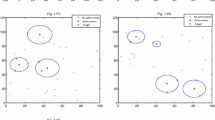Abstract
This paper addresses information-maximizing sensor selection that determines a set of measurement locations providing the largest entropy reduction in the estimates of the state variables. A new mixed-integer semidefinite program (MISDP) formulation is proposed for this selection under the constraints resulting from communication limitations. This formulation employs binary variables indicating if the corresponding measurement location is selected, and ensures convexity of the objective function and linearity of the constraint functions by exploiting the linear equivalent form of a bilinear term involving binary variables. An outer-approximation algorithm is then developed for the MISDP formulation that obtains the global optimal solution by solving a sequence of mixed-integer linear programs for which reliable solvers are available. Numerical experiments verify the solution optimality and the computational effectiveness of the proposed algorithm by comparing it to branch-and-bound-based approaches with nonlinear programming relaxation. An example of sensor selection to track a moving target is considered to demonstrate the applicability of the proposed method and highlight its ability to handle quadratic constraints.
Similar content being viewed by others
References
Anstreicher K., Fampa M., Lee J., Williams J.: Using continuous nonlinear relaxations to solve constrained maximum-entropy sampling problems. Math. Progr. 85, 221–240 (1999)
Anstreicher K., Fampa M., Lee J., Williams J.: Maximum-entropy remote sampling. Discrete Appl. Math. 18(3), 211–226 (2001)
Anstreicher K.M.: Semidefinite programming versus the reformulation-linearization technique for nonconvex quadratically constrained quadratic programming. J. Glob. Optim. 43(2–3), 471–484 (2009)
Bertsekas D.: Dynamic Programming and Optimal Control, vol. I. Athena Scientific, Belmont (2005)
Boginski, V.L., Commander, C.W., Pardalos, P.M., Ye, Y. (eds): Sensors: Theory, Algorithms, and Applications. Springer, Berlin (2012)
Boyd S., Vandeberghe L.: Convex Optimization. Cambridge University Press, Cambridge (2004)
Bueso M., Angulo J., Alonso F.: A state-space model approach to optimum spatial sampling design based on entropy. Environ. Ecol. Stat. 5, 29–44 (1998)
Burer S., Lee J.: Solving maximum-entropy samping problems using factored masks. Math. Progr. 109(2–3), 263–281 (2007)
Cheng M.X., Gong X.: Maximum lifetime coverage preserving scheduling algorithms in sensor networks. J. Glob. Optim. 51(3), 447–462 (2011)
Choi H.L., How J.P.: Continuous trajectory planning of mobile sensors for informative forecasting. Automatica 46(8), 1266–1275 (2010)
Choi H.L., How J.P.: Coordinated targeting of mobile sensor networks for ensemble forecast improvement. IEEE Sens. J. 11(3), 621–633 (2011)
Choi H.L., How J.P.: Efficient targeting of sensor networks for large-scale systems. IEEE Trans. Control Syst. Technol. 19(6), 1569–1577 (2011)
Choi, H.L., How, J.P., Barton, P.I.: An outer-approximation algorithm for generalized maximum entropy sampling. In: American Control Conference (2008)
Cover T., Thomas J.: Elements of Information Theory. Wiley, New York (1991)
CPLEX: http://www.ilog.com/products/cplex/. Accessed Mar 2009
Duran M., Grossmann I.: An outer-approximation algorithm for a class of mixed-integer nonlinear programs. Math. Progr. 36(3), 307–339 (1986)
Fletcher R., Leyffer S.: Solving mixed integer nonlinear programs by outer approximation. Math. Progr. 66(1–3), 327–349 (1994)
Friedlander B., Weiss A.J.: On the second-order statistics of the eigenvectors of sample covariance matrices. IEEE Trans. Signal Process. 46(11), 3136–3139 (1998)
Glover F., Woosley E.: Converting the 0–1 polynomial programming problem to a 0–1 linear program. Oper. Res. 22(1), 180–182 (1972)
Grocholsky B., Keller J., Kumar V., Pappas J.: Cooperative air and ground surveillance. IEEE Robot. Autom. Mag. 13(3), 16–25 (2006)
Grocholsky, B., Makarenko, A., Durrant-Whyte, H.: Information-theoretic coordinated control of multiple sensor platforms. In: IEEE International Conference on Robotics and Automation, pp. 1521–1526. Taipei, Taiwan (2003)
Hirsch, M.J., Pardalos, P.M., Murphey, R. (eds): Dynamics of Information Systems. Springer, Berlin (2010)
Hoffman, A., Lee, J., Williams, J.: New upper bounds for maximum-entropy sampling. In: MODA 6—Advances in Model-Oriented Design and Analysis, pp. 143–153 (2001)
Hoffmann G., Tomlin C.J.: Mobile sensor network control using mutual information methods and particle filters. IEEE Trans. Autom. Control 55(1), 32–47 (2010)
Horn R.A., Johnson C.: Matrix Analysis. Cambridge University Press, Cambridge (1985)
Johnstone I.M.: On the distribution of the largest eigenvalue in principal components analysis. Ann. Stat. 29(2), 295–327 (2001)
Kesavan P., Allgor R., Gatzke E., Barton P.I.: Outer approximation algorithms for separable nonconvex mixed-integer nonlinear programs. Math. Progr. Ser. A 100(3), 517–535 (2004)
Kesavan P., Barton P.: Decomposition algorithms for nonconvex mixed-integer nonlinear programs. AIChE Symp. Ser. 96(323), 458–461 (1999)
Ko C.W., Lee J., Queyranne M.: An exact algorithm for maximum entropy sampling. Oper. Res. 43(4), 684–691 (1995)
Krause A., Singh A., Guestrin C.: Near-optimal sensor placements in Gaussian processes: Theory, efficient algorithms and empirical studies. J. Mach. Learn. Res. 9(2), 235–284 (2008)
Lee J.: Constrained maximum-entropy sampling. Oper. Res. 46(5), 655–664 (1998)
Lee J., Williams J.: A linear integer programming bound for maximum-entropy sampling. Math. Progr. Ser. B 94, 247–256 (2003)
Park S., Choi H.-L., Roy R., How J.P.: Learning the covariance dynamics of a large-scale environment for informative path planning of unmanned aerial vehicle sensors. Int. J. Aeronaut. Space Sci. 11(4), 326–337 (2010)
Shewry M., Wynn H.: Maximum entropy sampling. J. Appl. Stat. 46, 165–170 (1987)
TOMLAB BARNLP: http://tomopt.com/docs/tomlab/tomlab004.php. Accessed Feb 2012
TOMLAB CPLEX: http://tomopt.com/tomlab/products/cplex/. Accessed Mar 2009
TOMLAB KNITRO: http://tomopt.com/tomlab/products/knitro/. Accessed Mar 2009
Wang, H., Yao, K., Pottie, G., Estrin, D.: Entropy-based sensor selection heuristic for target localization. In: International Symposium on Information Processing in Sensor Networks, pp. 36–45. Berkeley (2004)
Williams J.L., Fisher J.W. III, Willsky A.S.: Approximate dynamic programming for communication-constrained sensor network management. IEEE Trans. Signal Process. 55(8), 3995–4003 (2007)
Zhang Y., Ji Q.: An algorithm for the construction of ‘d k -optimal’ experimental designs. Technometrics 16, 203–210 (1974)
Author information
Authors and Affiliations
Corresponding author
Rights and permissions
About this article
Cite this article
Choi, HL., How, J.P. & Barton, P.I. An outer-approximation approach for information-maximizing sensor selection. Optim Lett 7, 745–764 (2013). https://doi.org/10.1007/s11590-012-0457-9
Received:
Accepted:
Published:
Issue Date:
DOI: https://doi.org/10.1007/s11590-012-0457-9




